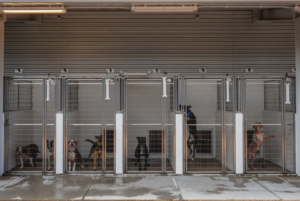Last Updated on September 20, 2023 by Fumipets
America’s Pets Crisis: Animal Shelters Overwhelmed by Abandoned Cats and Dogs
The Struggle to Cope as Animal Shelters Reach Breaking Point
In the early days of the Covid-19 pandemic, with millions of Americans grappling with loneliness and isolation, a heartwarming trend emerged. People turned to furry companions for solace, adopting and fostering cats and dogs from animal shelters at an unprecedented rate. Videos of empty shelters went viral, prompting Wired to dub it “the feel-good pandemic story you need right now.”
Bobby Mann, Chief Programs Officer of the Humane Rescue Alliance, Washington D.C.’s largest animal shelter, reminisced, “It was a really fun time to be in animal welfare. We did absolutely see an uptick in adoptions.”
But as we ventured further into 2021, a troubling shift occurred. Shelters began filling up again, with more animals entering than leaving. Now, many shelters are stretched to their limits. From coast to coast, shelters are sounding the alarm, reporting full capacity and resorting to euthanizing dogs due to overcrowding. In a recent survey, nearly half of the shelters noted an increase in euthanized dogs, while only 10 percent reported a decrease.
A Cry for Help: Shelters in Crisis
Stephanie Filer, Executive Director of Shelter Animals Count, an organization that aggregates data from thousands of shelters, emphasized the gravity of the situation: “By and large, shelters are screaming from the rooftops that they’ve been in crisis for a while, and it’s not letting up.” Disturbingly, this crisis is predicted to worsen further this year.

This disconcerting trend jeopardizes the significant progress made by animal shelters since the 1970s when over one-fifth of the 65 million dogs and cats in the US were euthanized. In 2019, less than one million dogs and cats, about 0.7 percent of the country’s 135 million, were put down.
The Dark Reality: Balancing Act for Shelters
Unlike excess Peloton bikes gathering dust in warehouses, dealing with surplus animals is a far more heart-wrenching ordeal. Animal shelters are grappling with the agonizing choice between squeezing more animals into already crowded spaces, euthanizing them, or turning them away.
What’s Fueling America’s Animal Shelter Crisis?
The gravity of America’s animal shelter crisis can be gauged by a simple metric: the population gap, which measures how many animals enter shelters versus how many leave. In 2020, during the peak of pet adoptions, 2 percent more animals left shelters than entered over the year. However, in 2021, the trend reversed with 2 percent more animals entering shelters than leaving. By 2022, this discrepancy escalated to a 4 percent surplus of animals entering shelters, each percentage point representing tens of thousands of animals.
Shelter Animals Count predicts that by the end of 2023, the population gap could rise to a staggering 5 percent.
The surge in shelter intakes is primarily attributed to the influx of stray animals. While owner surrenders have decreased, there has been an 8 percent increase in stray intakes from January to June 2023 compared to the same period in 2022. But the reasons behind this surge remain somewhat elusive.
The Financial Strain: A Barrier to Pet Ownership
For many, the financial burden of pet ownership is overwhelming, particularly in the context of the ongoing affordable housing crisis. Affordable, pet-friendly housing is increasingly scarce, with numerous apartment buildings banning certain breeds or larger dogs. This shortage has led shelters to witness a surge in the intake of large dogs weighing over 40–50 pounds.
As Shelter Animals Count’s Stephanie Filer aptly notes, “The same [economic] trends that affect people always affect animals.” Skyrocketing inflation and a national housing crisis, marked by rising eviction rates and homelessness, have intensified housing insecurity, compelling people to surrender their beloved pets as a last resort.
The Pandemic’s Unintended Consequences
Another perplexing facet is the high rate of stray animals, which could be a ripple effect of increased pet acquisitions early in the pandemic. As pets adjusted to post-pandemic life, some struggled to adapt, resulting in behavioral issues. Owners grappling with these challenges found themselves surrendering their pets.
A Glimmer of Hope: Cats in the Spotlight
Amid this disheartening scenario, there is a silver lining – a surge in cat adoptions. Cats are currently being adopted at a higher rate than dogs, offering a more budget-friendly and less restrictive alternative in the face of housing challenges and inflation.
How You Can Make a Difference
- Adopt: Opt to adopt animals from shelters rather than purchasing from breeders.
- Foster: Consider fostering animals if long-term pet ownership is not feasible.
- Volunteer: Lend a helping hand by volunteering at shelters.
- Donate: Shelters desperately need financial support as they work tirelessly to care for animals in need.
By actively participating in these initiatives, you can play a crucial role in alleviating the crisis gripping our nation’s animal shelters.
Conclusion: A National Crisis Reflecting Our Relationship with Animals
The current animal shelter crisis not only mirrors the national housing crisis but also highlights our complex relationship with animals. While dogs are celebrated as “man’s best friend,” we simultaneously breed many to suffer, with millions languishing in shelters. The progress made in reducing euthanasia rates in shelters is in jeopardy unless we rethink how we acquire pets and step up to open our homes and wallets to shelter animals.
In an effort to address this crisis, shelters have introduced programs to make pet adoption and ownership more affordable. These include pet food banks, low-cost vaccine clinics, and home veterinary services. Supporting such initiatives, whether through adoption or financial contributions, can make a significant difference in the lives of countless animals.


















